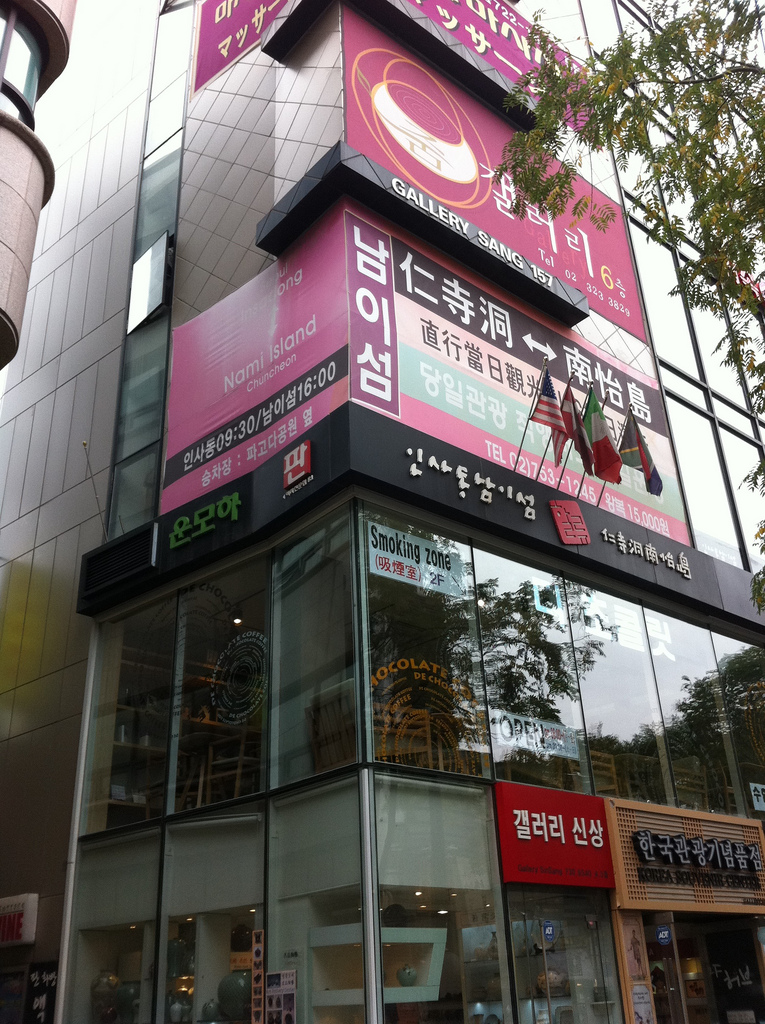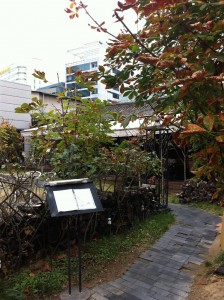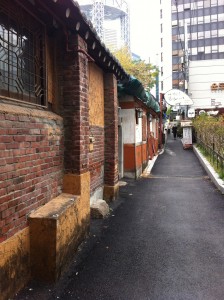I will spare everyone the ongoing epic poem I am crafting of my love for mobile learning, except to say that I did all of the following using only my iPhone and had most of the elements online (described, positioned, and tagged) by the time I got off the subway coming home (<20 minutes). What I was able to do was use Naver/Google Maps to geolocate an address retrieved from a Flickr photo of a Hyun (현) family registry and then navigate my way there, record images and video, upload those and tag them, map them, and now present all of this in blog format. This blog post I am writing from my laptop; everything else was from the iPhone. This is exactly how I see the future intersection of mobile learning and History/Cultural Heritage disciplinary practice. Immediate (accurate) data collection, positioned (contextualized), researched (background and crowdsourced participation), and reflected (blogged or full paper). Hunches leading to hypothesis leading to research and corroboration leading to ephemeral connections leading to serendipitous discovery. Mobile learning puts you in the field and keeps you there and drastically speeds up the process for hypothesizing, discovering, and presenting evidence.
And I should also mention that all of this was done on request from my father in-law, who had asked to see some images from one of the few things he remembers clearly of Seoul, namely Tapkol Park (탑골 공원). This park would have been next to his childhood home of Insadong (인사동), itself now one big tourist attraction. What is remarkable from my perspective is that I worked across the street from this park for five years and never knew my wife’s father grew up here. I wrote in an earlier post the other day that he grew up on Supyoro next to Cheonggyecheon, but I had misread the Family Registry. This was the home of the head of household in the Hyun (현) family, my wife’s great grandfather. Her grandfather, aka my father in-law’s husband owned a home at the entrance to Insadong (only about a 1/2 mile away).
If you want to follow along with my journey geographically, please feel free to grab the KML from today’s expedition and view in Google Earth (or Maps).
So, I went and first documented Tapkol Park (탑골 공원) as best I could to contextualize the geography of the location for my father in-law. He remembered old pensioners hanging out there (and they still do in droves) and so I sat there and recorded video of the old guys talking. I took pictures of all the directional points of the entrances (N,S,E,W) and mapped them. I captured the beautiful Wongaksa Pagoda (1471) (원각사지십층석탑), Korea’s National Treasure #2, and Palgakjeong pavilion (팔각정) where the Korean Declaration of Independence was read on March 1st 1919, thus kicking off the National Independence Movement. I provided as much detail as possible to paint a picture for him. My father in-law is a very sharp man with an amazing memory, but he hasn’t been in Korea since 1965 so contextualizing as much as possible seemed prudent.
Next, I walked from Tapkol Park to Insadong (인사동). Insadong is a very touristy place selling very expensive arts and crafts, an enjoyable place to stroll every so often. For my father in-law it was his home (very prosperous by Korean standards), a home his father sold after he retired (and my father in-law had already left Korea) and bought three houses in the Ewha Women’s University area (another detective job for another day). Using the address from the Family Registry and Naver and Google Maps, I found (as best as possible) the location of his home. It is either part of this beheamoth art gallery:
Or is the structure immediately behind it, which is now a cafe but has maintained much of the older structure of the home that once was here. It is hard to tell from this photograph as the house itself is beyond this garden area.
This would have been the alley that led to these structures, the same one that my father in-law would have walked everyday to school, to the market, to the tram, to the bus, and then eventually this alley would have led him for the last time to Kimpo Airport and the United States. He never saw it again.
These little histories give me incredible amounts of joy as they reconstruct place and loved ones places in them. My father in-law’s story is one of migration, of mobility itself, yet it all started, as stories always do, in some house, on some block, in some neighborhood. Narrative history demonstrates that the way we start needn’t be the way we finish, that life is motion and that motion leaves a residue of remembrance. Once again, it just harkens back to why I love History and Cultural Heritage so much and what promise mobile technology brings to their practice. There are stories to tell, record, and make accessible; there are memories to embed in places and people. There is reflection to be crafted on our places within the larger forces of change. There are decisions to be made about the course of our lives and what we learned from them. There is knowledge to be transmitted to later generations. There is Michael Gallagher stopping the gushing clumsy poetics.
On a practical note, I am also realizing there is great potential in using mobile to contextualize places or periods of time in gathering oral interviews from participants. An initial interview with a participant to gather logistical information, then the researcher crafts a contextualizing environment (a map with embedded images, video, audio, perhaps even a Street View walkthrough), then a follow up interview after the participant has ‘revisited’ the place virtually. I suspect it would produce much deeper dives into narrative history than previously imagined. I suspect this could be quite useful if there were ever to be a large scale Korean War oral history project or something along those lines. If you have made it this far and want to see the map, click here.





